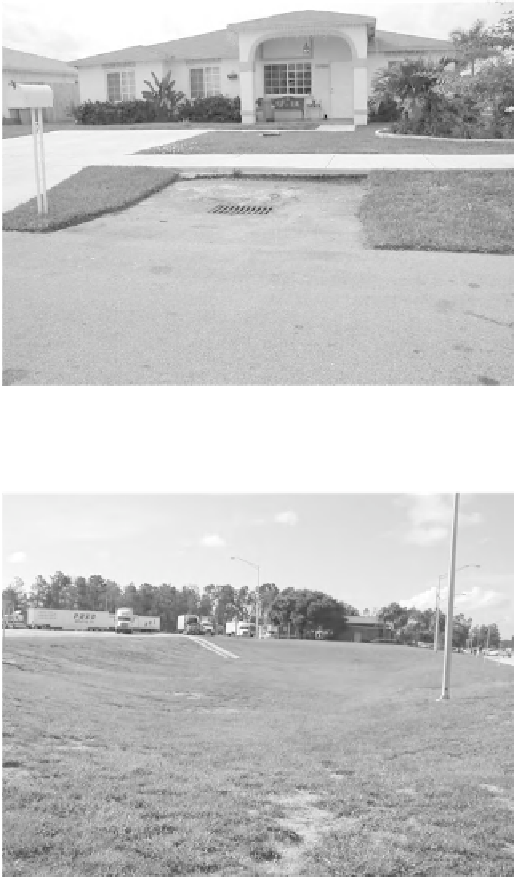Environmental Engineering Reference
In-Depth Information
the concrete-lined drainage channel leading
from the parking lot to the infiltration basin is
clearly apparent at the far end of the basin.
Infiltration basins need to drain down and
dry out in a reasonable period of time to
prevent sealing of the bottom by a slime layer
of algae, bacteria, and fungi. If water is allowed
to sit in the bottom of the basin for more than
72 hours (= 3 days) in most climates, the condi-
tions to allow slime formation are high
(Novotny, 2003). The following formula can be
used to calculate the maximum allowable
ponding depth in a basin to achieve a given
design ponding time:
d
max
=
fT
p
(6.22)
Figure 6.6.
Direct connection between roadway and a storm-
water inlet.
where
d
max
is the maximum design depth (L),
f
is the soil infiltration rate (LT
−1
), and
T
p
is
the design ponding time (T). To maintain the
infiltration capacity of the basin, it is impor-
tant that excessive sediment loadings be
avoided. Studies in Florida have found that
infiltration basins with grass bottoms tend to
perform better than basins with earthen
bottoms. Maintenance needs include annual
inspections and inspections after large storms,
mowing at least twice per year, debris removal,
erosion control, and control of nuisance odor
or mosquito problems. Deep tilling may be
needed at 5- to 10-year intervals to break up
a clogged surface layer.
(b)
Infiltration Trenches.
A conventional infiltra-
tion trench is a shallow excavated trench
that has been backfilled with stone to create an
underground reservoir. Infiltration trenches
work similar to infiltration basins and have
similar pollutant removal capabilities. An infil-
tration trench under construction is shown in
Figure 6.8a, where the coarse aggregate used
to fill the trench and the porous pipe used to
deliver runoff to the trench (via a catch basin)
are clearly apparent. The completed infiltra-
tion trench is shown in Figure 6.8b. Mainte-
nance requirements for infiltration trenches
include inspections annually and after large
storms, buffer strip maintenance and mowing,
and rehabilitation of the trench when clogging
begins to occur. Surface clogging can be rem-
edied by replacing the top layer of the trench,
but bottom clogging requires the removal
of all of the filter and stone aggregate. To mini-
mize the likelihood that the trench becomes
Figure 6.7.
Infiltration basin.
Increasing Infiltration.
Infiltration basins and infiltra-
tion trenches are the most commonly used struc-
tures for increasing the infiltration of stormwater
runoff. These practices are described in more
detail below.
(a)
Infiltration Basins.
An infiltration basin is
made by constructing an embankment or by
excavating an area down to relatively perme-
able soils. Infiltration basins store stormwater
runoff temporarily until it infiltrates through
the bottom and sides of the basin. These basins
are normally dry and can be incorporated into
the landscape design as open areas or even
recreational areas, such as sports fields. An
example of an infiltration basin draining a
large parking lot is shown in Figure 6.7, where

Search WWH ::

Custom Search